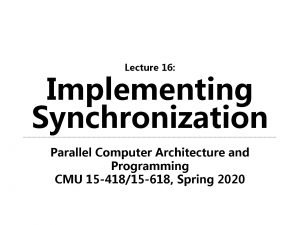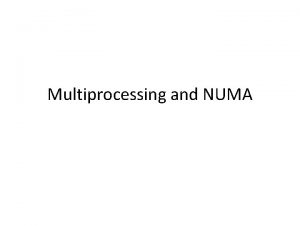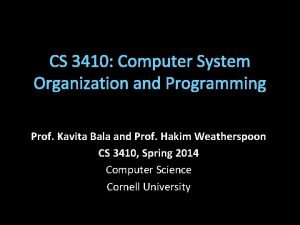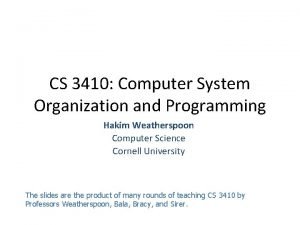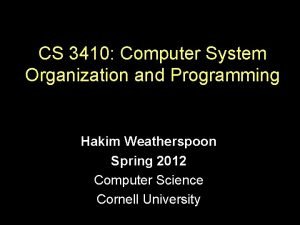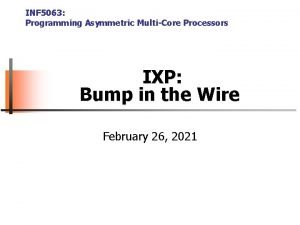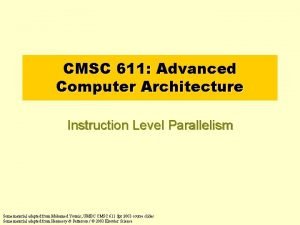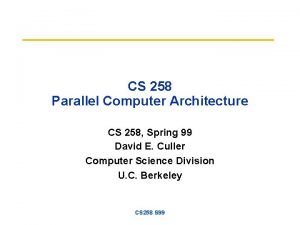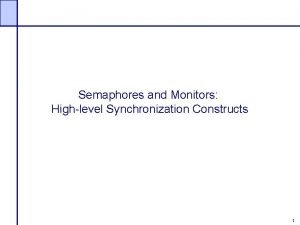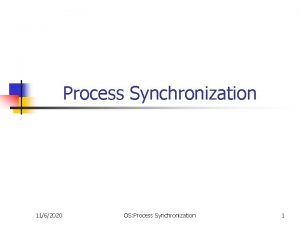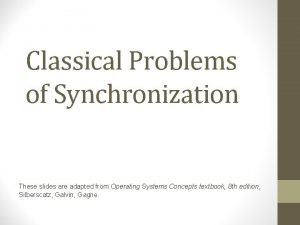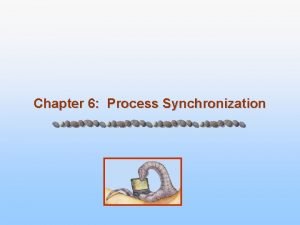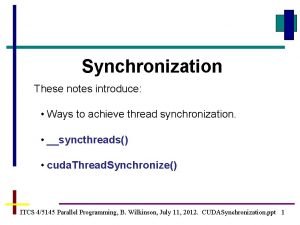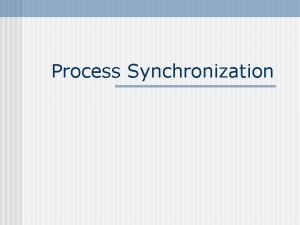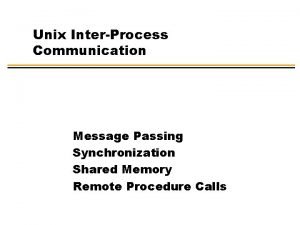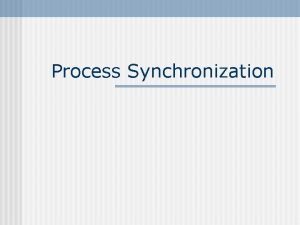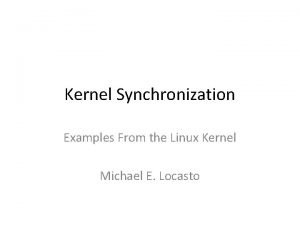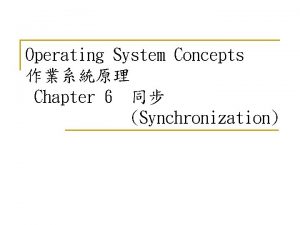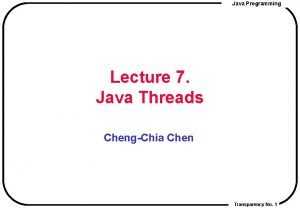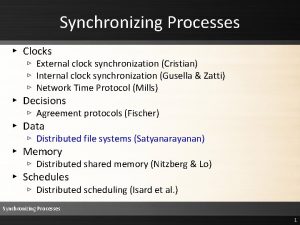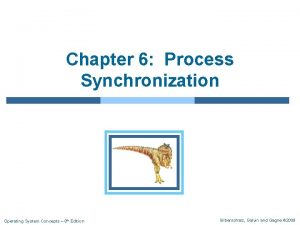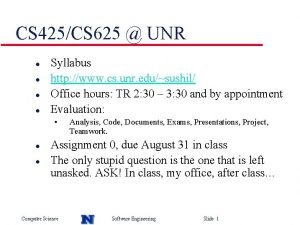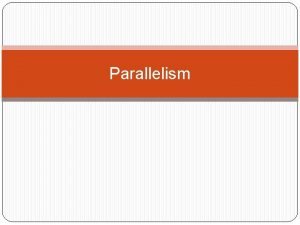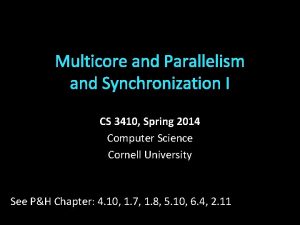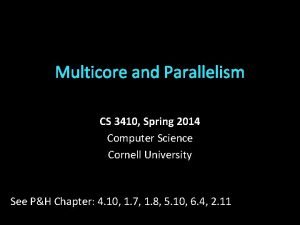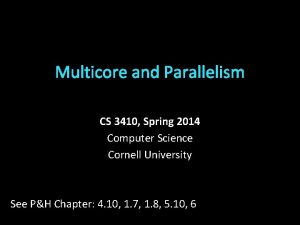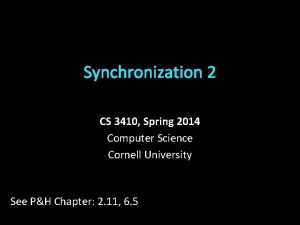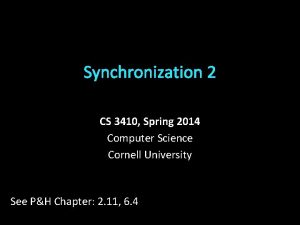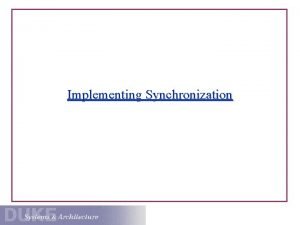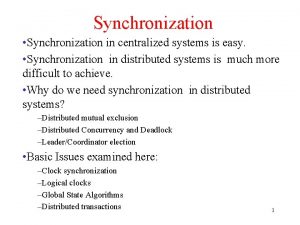Parallelism Multicore and Synchronization CS 3410 Computer Science






































































































![Condition variables Use [Hoare] a condition variable to wait for a condition to become Condition variables Use [Hoare] a condition variable to wait for a condition to become](https://slidetodoc.com/presentation_image_h2/9c61ace4f3f34cfc87f8f209522d7a6d/image-103.jpg)





- Slides: 108

Parallelism, Multicore, and Synchronization CS 3410 Computer Science Cornell University The slides are the product of many rounds of teaching CS 3410 by Professors Weatherspoon, Bala, Bracy, Mc. Kee, and Sirer. Also some slides from Amir Roth & Milo Martin in here. 1

Announcements • C practice assignment • Due Monday, April 23 rd • P 4 -Buffer Overflow is due tomorrow • Due Wednesday, April 18 th • P 5 -Cache Collusion! • Due Friday, April 27 th • Pizza party & Tournament, Monday, May 7 th • Prelim 2 • Thursday, May 3 rd, 7 pmn 185 Statler Hall

xkcd/619

Pitfall: Amdahl’s Law Execution time after improvement = affected execution time amount of improvement + execution time unaffected

Pitfall: Amdahl’s Law Improving an aspect of a computer and expecting a proportional improvement in overall performance Example: multiply accounts for 80 s out of 100 s • Multiply can be parallelized

Scaling Example Workload: sum of 10 scalars, and 10 × 10 matrix sum • Speed up from 10 to 100 processors? Single processor: Time = (10 + 100) × tadd 10 processors 100 processors

Takeaway Unfortunately, we cannot obtain unlimited scaling (speedup) by adding unlimited parallel resources, eventual performance is dominated by a component needing to be executed sequentially. Amdahl's Law is a caution about this diminishing return

Performance Improvement 101 seconds program = instructions program x cycles instruction x seconds cycle 2 Classic Goals of Architects: �Clock period (�Clock frequency) �Cycles per Instruction (�IPC) 9

Clock frequencies have stalled Darling of performance improvement for decades Why is this no longer the strategy? Hitting Limits: • • Pipeline depth Clock frequency Moore’s Law & Technology Scaling Power 10

Improving IPC via ILP Exploiting Intra-instruction parallelism: Pipelining (decode A while fetching B) Exploiting Instruction Level Parallelism (ILP): Multiple issue pipeline (2 -wide, 4 -wide, etc. ) • Statically detected by compiler (VLIW) • Dynamically detected by HW Dynamically Scheduled (Oo. O) 11

Instruction-Level Parallelism (ILP) Pipelining: execute multiple instructions in parallel Q: How to get more instruction level parallelism? A: Deeper pipeline – E. g. 250 MHz 1 -stage; 500 Mhz 2 -stage; 1 GHz 4 -stage; 4 GHz 16 -stage Pipeline depth limited by… – max clock speed (less work per stage shorter clock cycle) – min unit of work – dependencies, hazards / forwarding logic

Instruction-Level Parallelism (ILP) Pipelining: execute multiple instructions in parallel Q: How to get more instruction level parallelism? A: Multiple issue pipeline – Start multiple instructions per clock cycle in duplicate stages

Static Multiple Issue a. k. a. Very Long Instruction Word (VLIW) Compiler groups instructions to be issued together • Packages them into “issue slots” How does HW detect and resolve hazards? It doesn’t. Compiler must avoid hazards Example: Static Dual-Issue 32 -bit MIPS • Instructions come in pairs (64 -bit aligned) – One ALU/branch instruction (or nop) – One load/store instruction (or nop) 15

MIPS with Static Dual Issue Two-issue packets • One ALU/branch instruction • One load/store instruction • 64 -bit aligned – ALU/branch, then load/store – Pad an unused instruction with nop Address Instruction type Pipeline Stages n ALU/branch IF ID EX MEM WB n+4 Load/store IF ID EX MEM WB n+8 ALU/branch IF ID EX MEM WB n + 12 Load/store IF ID EX MEM WB n + 16 ALU/branch IF ID EX MEM WB n + 20 Load/store IF ID EX MEM WB 16

Scheduling Example Schedule this for dual-issue MIPS Loop: lw addu sw addi bne $t 0, $s 1, ALU/branch 0($s 1) $t 0, $s 2 0($s 1) $s 1, – 4 $zero, Loop # # # Load/store $t 0=array element add scalar in $s 2 store result decrement pointer branch $s 1!=0 cycle

Techniques and Limits of Static Scheduling Goal: larger instruction windows (to play with) • Predication • Loop unrolling • Function in-lining • Basic block modifications (superblocks, etc. ) Roadblocks • Memory dependences (aliasing) • Control dependences 18

Speculation Reorder instructions To fill the issue slot with useful work Complicated: exceptions may occur

Optimizations to make it work Move instructions to fill in nops Need to track hazards and dependencies Loop unrolling

Scheduling Example Compiler scheduling for dual-issue MIPS… Loop: lw $t 0, 0($s 1) # $t 0 = A[i] lw $t 1, 4($s 1) # $t 1 = A[i+1] addu $t 0, $s 2 # add $s 2 addu $t 1, $s 2 # add $s 2 sw $t 0, 0($s 1) # store A[i] sw $t 1, 4($s 1) # store A[i+1] addi $s 1, +8 # increment pointer bne $s 1, $s 3, Loop # continue if $s 1!=end ALU/branch slot Loop: nop addu $t 0, $s 2 addu $t 1, $s 2 addi $s 1, +8 bne $s 1, $s 3, Loop Load/store lw $t 0, lw $t 1, nop sw $t 0, sw $t 1, nop slot 0($s 1) 4($s 1) cycle 1 2 3 4 5 6

Limits of Static Scheduling Compiler scheduling for dual-issue MIPS… lw addi sw $t 0, 0($s 1) $t 0, +1 $t 0, 0($s 1) $t 0, 0($s 2) $t 0, +1 $t 0, 0($s 2) ALU/branch slot nop nop addi $t 0, +1 nop # load A # # # load B # # increment A store A increment B store B Load/store lw $t 0, nop nop sw $t 0, slot 0($s 1) 0($s 2) cycle 1 2 3 4 5 6 7 8

Improving IPC via ILP Exploiting Intra-instruction parallelism: Pipelining (decode A while fetching B) Exploiting Instruction Level Parallelism (ILP): Multiple issue pipeline (2 -wide, 4 -wide, etc. ) • Statically detected by compiler (VLIW) • Dynamically detected by HW Dynamically Scheduled (Oo. O) 23

Dynamic Multiple Issue aka Super. Scalar Processor (c. f. Intel) • CPU chooses multiple instructions to issue each cycle • Compiler can help, by reordering instructions…. • … but CPU resolves hazards Even better: Speculation/Out-of-order Execution • • • Execute instructions as early as possible Aggressive register renaming (indirection to the rescue!) Guess results of branches, loads, etc. Roll back if guesses were wrong Don’t commit results until all previous insns committed 24

Dynamic Multiple Issue

Effectiveness of Oo. O Superscalar It was awesome, but then it stopped improving Limiting factors? • Programs dependencies • Memory dependence detection be conservative – e. g. Pointer Aliasing: A[0] += 1; B[0] *= 2; • Hard to expose parallelism – Still limited by the fetch stream of the static program • Structural limits – Memory delays and limited bandwidth • Hard to keep pipelines full, especially with branches 26

Improving IPC via ILP TLP Exploiting Thread-Level parallelism Hardware multithreading to improve utilization: • • Multiplexing multiple threads on single CPU Sacrifices latency for throughput Single thread cannot fully utilize CPU? Try more! Three types: • Course-grain (has preferred thread) • Fine-grain (round robin between threads) • Simultaneous (hyperthreading) 27

What is a thread? Process: multiple threads, code, data and OS state Threads: share code, data, files, not regs or stack 28

Standard Multithreading Picture Time evolution of issue slots time • Color = thread, white = no instruction 4 -wide Superscalar CGMT Switch to thread B on thread A L 2 miss FGMT Switch threads every cycle Insns from multiple threads coexist 29

Power Efficiency Q: Does multiple issue / ILP cost much? A: Yes. Dynamic issue and speculation requires power CPU Year Clock Rate Pipeline Stages Issue width Out-of-order/ Cores Speculation Power i 486 1989 25 MHz 5 1 No 1 5 W Pentium 1993 66 MHz 5 2 No 1 10 W Pentium Pro 1997 200 MHz 10 3 Yes 1 29 W P 4 Willamette 2001 2000 MHz 22 3 Yes 1 75 W Ultra. Sparc III 2003 1950 MHz 14 4 No 1 90 W P 4 Prescott 2004 3600 MHz 31 3 Yes 1 103 W

Dual-core Moore’s Law. Itanium 2 K 10 Itanium 2 K 8 P 4 Atom 486 386 286 8088 8080 4004 8008 Pentium

Why Multicore? Moore’s law • A law about transistors • Smaller means more transistors per die • And smaller means faster too But: Power consumption growing too…

Power Limits Surface of Sun Rocket Nozzle Nuclear Reactor Xeon Hot Plate 180 nm 32 nm

Power Wall Power = capacitance * voltage 2 * frequency In practice: Power ~ voltage 3 Lower Frequency Reducing voltage helps (a lot). . . so does reducing clock speed Better cooling helps The power wall • We can’t reduce voltage further • We can’t remove more heat

Why Multicore? Performance Power 1. 2 x Single-Core 1. 7 x Overclocked +20% Performance Power 1. 0 x Performance Power 0. 8 x 1. 6 x 0. 51 x 1. 02 x Single-Core Dual-Core Single-Core Underclocked -20%

Power Efficiency Q: Does multiple issue / ILP cost much? A: Yes. Dynamic issue and speculation requires power CPU Year Clock Rate Pipeline Stages Issue width Out-of-order/ Cores Speculation Power i 486 1989 25 MHz 5 1 No 1 5 W Pentium 1993 66 MHz 5 2 No 1 10 W Pentium Pro 1997 200 MHz 10 3 Yes 1 29 W P 4 Willamette 2001 2000 MHz 22 3 Yes 1 75 W Ultra. Sparc III 2003 1950 MHz 14 4 No 1 90 W P 4 Prescott 2004 3600 MHz 31 3 Yes 1 103 W Core 2006 2930 MHz 14 4 Yes 2 75 W Core i 5 Nehal 2010 3300 MHz 14 4 Yes 1 87 W Core i 5 Ivy Br 2012 3400 MHz 14 4 Yes 8 77 W Ultra. Sparc T 1 2005 1200 MHz 6 1 No 8 70 W Those simpler cores did something very right.

Inside the Processor AMD Barcelona Quad-Core: 4 processor cores

Inside the Processor Intel Nehalem Hex-Core 4 -wide pipeline

Example: All of the above 8 die (aka 8 sockets) 4 core per socket 2 HT per core Note: a socket is a processor, where each processor may have multiple processing cores, so this is an example of a multiprocessor multicore hyperthreaded system

Parallel Programming Q: So lets just all use multicore from now on! A: Software must be written as parallel program Multicore difficulties • • Partitioning work Coordination & synchronization Communications overhead How do you write parallel programs? . . . without knowing exact underlying architecture? 41

Work Partitioning Partition work so all cores have something to do

Load Balancing Need to partition so all cores are actually working

Amdahl’s Law If tasks have a serial part and a parallel part… Example: step 1: divide input data into n pieces step 2: do work on each piece step 3: combine all results Recall: Amdahl’s Law As number of cores increases … • time to execute parallel part? goes to zero • time to execute serial part? Remains the same • Serial part eventually dominates

Amdahl’s Law

Parallelism is a necessity Necessity, not luxury Power wall Not easy to get performance out of Many solutions Pipelining Multi-issue Hyperthreading Multicore

Parallel Programming Q: So lets just all use multicore from now on! A: Software must be written as parallel program Multicore difficulties • • Partitioning work SW Your Coordination & synchronization career… Communications overhead HW How do you write parallel programs? . . . without knowing exact underlying architecture? 47

Big Picture: Parallelism and Synchronization How do I take advantage of parallelism? How do I write (correct) parallel programs? What primitives do I need to implement correct parallel programs?

Topics: Goals for Today Understand Cache Coherency Synchronizing parallel programs • Atomic Instructions • HW support for synchronization How to write parallel programs • Threads and processes • Critical sections, race conditions, and mutexes

Parallelism and Synchronization Cache Coherency Problem: What happens when to two or more processors cache shared data?

Parallelism and Synchronization Cache Coherency Problem: What happens when to two or more processors cache shared data? i. e. the view of memory held by two different processors is through their individual caches. As a result, processors can see different (incoherent) values to the same memory location.

Parallelism and Synchronization

Parallelism and Synchronization Each processor core has its own L 1 cache

Parallelism and Synchronization Each processor core has its own L 1 cache

Parallelism and Synchronization Each processor core has its own L 1 cache Core 0 Cache Core 1 Cache Core 2 Cache Interconnect Memory I/O Core 3 Cache

Shared Memory Multiprocessors Shared Memory Multiprocessor (SMP) • Typical (today): 2 – 4 processor dies, 2 – 8 cores each • HW provides single physical address space for all processors • Assume physical addresses (ignore virtual memory) • Assume uniform memory access (ignore NUMA) Core 0 Cache Core 1 Cache Core 2 Cache Interconnect Memory I/O Core 3 Cache

Shared Memory Multiprocessors Shared Memory Multiprocessor (SMP) • Typical (today): 2 – 4 processor dies, 2 – 8 cores each • HW provides single physical address space for all processors • Assume physical addresses (ignore virtual memory) • Assume uniform memory access (ignore NUMA) Core 0 Cache Core 1 Cache . . Interconnect Memory I/O Core. N Cache

Cache Coherency Problem Thread A (on Core 0) Thread B (on Core 1) for(int i = 0, i < 5; i++) { for(int j = 0; j < 5; j++) { x = x + 1; } } What will the value of x be after both loops finish? Core 0 Cache Core 1 Cache . . Interconnect Memory I/O Core. N Cache

Cache Coherence Problem Suppose two CPU cores share a physical address space • Write-through caches Time Event step CPU A’s cache CPU B’s cache 0 Core 0 Cache Memory 0 Core 1 Cache . . Interconnect Memory I/O Core. N Cache

Two issues Coherence What values can be returned by a read Consistency When a written value will be returned by a read

Coherence Defined Informal: Reads return most recently written value Formal: For concurrent processes P 1 and P 2 • P writes X before P reads X (with no intervening writes) read returns written value – (preserve program order) • P 1 writes X before P 2 reads X read returns written value – (coherent memory view, can’t read old value forever) • P 1 writes X and P 2 writes X all processors see writes in the same order – all see the same final value for X – Aka write serialization – (else PA can see P 2’s write before P 1’s and PB can see the opposite; their final understanding of state is wrong)

Cache Coherence Protocols Operations performed by caches in multiprocessors to ensure coherence • Migration of data to local caches – Reduces bandwidth for shared memory • Replication of read-shared data – Reduces contention for access Snooping protocols • Each cache monitors bus reads/writes

Snooping for Hardware Cache Coherence • All caches monitor bus and all other caches • Bus read: respond if you have dirty data • Bus write: update/invalidate your copy of data Core 0 Snoop Cache Core 1 Snoop Cache . . Interconnect Memory I/O Core. N Snoop Cache

Invalidating Snooping Protocols Cache gets exclusive access to a block when it is to be written • Broadcasts an invalidate message on the bus • Subsequent read in another cache misses – Owning cache supplies updated value Time Step CPU activity 0 Bus activity CPU A’s cache CPU B’s cache Memory 0 1 CPU A reads X 2 CPU B reads X 3 CPU A writes 1 to X 4 CPU B read X

Writing Write-back policies for bandwidth Write-invalidate coherence policy • First invalidate all other copies of data • Then write it in cache line • Anybody else can read it Permits one writer, multiple readers In reality: many coherence protocols • Snooping doesn’t scale • Directory-based protocols – Caches and memory record sharing status of blocks in a directory

Takeaway: Summary of cache coherence Informally, Cache Coherency requires that reads return most recently written value Cache coherence hard problem Snooping protocols are one approach

Next Goal: Synchronization Is cache coherency sufficient? i. e. Is cache coherency (what values are read) sufficient to maintain consistency (when a written value will be returned to a read). Both coherency and consistency are required to maintain consistency in shared memory programs.

Synchronization • Threads • Critical sections, race conditions, and mutexes • Atomic Instructions • • HW support for synchronization Using sync primitives to build concurrency-safe data structures • Example: thread-safe data structures • Language level synchronization • Threads and processes

Programming with Threads Need it to exploit multiple processing units …to parallelize for multicore …to write servers that handle many clients Problem: hard even for experienced programmers • Behavior can depend on subtle timing differences • Bugs may be impossible to reproduce Needed: synchronization of threads

Programming with threads Within a thread: execution is sequential Between threads? • No ordering or timing guarantees • Might even run on different cores at the same time Problem: hard to program, hard to reason about • Behavior can depend on subtle timing differences • Bugs may be impossible to reproduce Cache coherency is not sufficient… Need explicit synchronization to make sense of concurrency!

Programming with Threads Concurrency poses challenges for: Correctness • Threads accessing shared memory should not interfere with each other Liveness • Threads should not get stuck, should make forward progress Efficiency • Program should make good use of available computing resources (e. g. , processors). Fairness • Resources apportioned fairly between threads

Example: Multi-Threaded Program Apache web server void main() { setup(); while (c = accept_connection()) { req = read_request(c); hits[req]++; send_response(c, req); } cleanup(); }

Example: web server Each client request handled by a separate thread (in parallel) • Some shared state: hit counter, . . . Thread 52 read. . . hits addiu hits = hits + 1; write hits. . . Thread 205 read. . . hits addiu hits = hits + 1; write hits. . . (look familiar? ) Timing-dependent failure race condition • hard to reproduce hard to debug

Two threads, one counter Possible result: lost update! hits = 0 T 1 time LW (0) ADDIU/SW: hits = 1 hits = 0 + 1 T 2 LW (0) ADDIU/SW: hits = 0 + 1 Timing-dependent failure race condition • Very hard to reproduce Difficult to debug

Race conditions Def: timing-dependent error involving access to shared state Whether a race condition happens depends on • how threads scheduled • i. e. who wins “races” to instruction that updates state vs. instruction that accesses state Challenges about Race conditions • Races are intermittent, may occur rarely • Timing dependent = small changes can hide bug A program is correct only if all possible schedules are safe • Number of possible schedule permutations is huge • Need to imagine an adversary who switches contexts at the worst possible time

Critical sections What if we can designate parts of the execution as critical sections • Rule: only one thread can be “inside” a critical section Thread 52 Thread 205 CSEnter() read hits addi write hits CSExit()

Critical Sections To eliminate races: use critical sections that only one thread can be in • Contending threads must wait to enter T 2 T 1 time CSEnter(); Critical section CSExit(); T 1 CSEnter(); # wait Critical section CSExit(); T 2

Mutexes Q: How to implement critical sections in code? A: Lots of approaches…. Mutual Exclusion Lock (mutex) lock(m): wait till it becomes free, then lock it unlock(m): unlock it safe_increment() { pthread_mutex_lock(&m); hits = hits + 1; pthread_mutex_unlock(&m); }

Mutexes Only one thread can hold a given mutex at a time Acquire (lock) mutex on entry to critical section • Or block if another thread already holds it Release (unlock) mutex on exit • Allow one waiting thread (if any) to acquire & proceed pthread_mutex_init(&m); pthread_mutex_lock(&m); # wait hits = hits+1; # wait pthread_mutex_unlock(&m); hits = hits+1; pthread_mutex_unlock(&m); T 1 T 2

Next Goal How to implement mutex locks? What are the hardware primitives? Then, use these mutex locks to implement critical sections, and use critical sections to write parallel safe programs

Synchronization requires hardware support • Atomic read/write memory operation • No other access to the location allowed between the read and write • Could be a single instruction – E. g. , atomic swap of register ↔ memory (e. g. ATS, BTS; x 86) • Or an atomic pair of instructions (e. g. LL and SC; MIPS)


Synchronization in MIPS Load linked: LL rt, offset(rs) Store conditional: SC rt, offset(rs) • Succeeds if location not changed since the LL – Returns 1 in rt • Fails if location is changed – Returns 0 in rt Any time a processor intervenes and modifies the value in memory between the LL and SC instruction, the SC returns 0 in $t 0, causing the code to try again. i. e. use this value 0 in $t 0 to try again.

Synchronization in MIPS Load linked: LL rt, offset(rs) Store conditional: SC rt, offset(rs) • Succeeds if location not changed since the LL – Returns 1 in rt • Fails if location is changed – Returns 0 in rt Example: atomic incrementor Time Step Thread A Thread B 0 Thread A Thread B $t 0 Memory M[$s 0] 0 1 try: LL $t 0, 0($s 0) 2 ADDIU $t 0, 1 3 SC $t 0, 0($s 0) SC $t 0, 0 ($s 0) 4 BEQZ $t 0, try

Mutex from LL and SC Linked load / Store Conditional m = 0; // m=0 means lock is free; otherwise, if m=1, then locked mutex_lock(int *m) { while(test_and_set(m)){} } int test_and_set(int *m) { old = *m; LL Atomic SC *m = 1; return old; }

Mutex from LL and SC Linked load / Store Conditional m = 0; // m=0 means lock is free; otherwise, if m=1, then locked mutex_lock(int *m) { while(test_and_set(m)){} } int test_and_set(int *m) { try: LI $t 0, 1 LL $t 1, 0($a 0) SC $t 0, 0($a 0) BEQZ $t 0, try MOVE $v 0, $t 1 }

Mutex from LL and SC Linked load / Store Conditional m = 0; // m=0 means lock is free; otherwise, if m=1, then locked mutex_lock(int *m) { while(test_and_set(m)){} } int test_and_set(int *m) { try: LI $t 0, 1 LL $t 1, 0($a 0) SC $t 0, 0($a 0) BEQZ $t 0, try MOVE $v 0, $t 1

Mutex from LL and SC Linked load / Store Conditional m = 0; mutex_lock(int *m) { test_and_set: LI $t 0, 1 LL $t 1, 0($a 0) BNEZ $t 1, test_and_set SC $t 0, 0($a 0) BEQZ $t 0, test_and_set } mutex_unlock(int *m) { *m = 0;

Mutex from LL and SC Linked load / Store Conditional m = 0; This is called a Spin lock mutex_lock(int *m) { Aka spin waiting test_and_set: LI $t 0, 1 LL $t 1, 0($a 0) BNEZ $t 1, test_and_set SC $t 0, 0($a 0) BEQZ $t 0, test_and_set } mutex_unlock(int *m) { SW $zero, 0($a 0)

Mutex from LL and SC Linked load / Store Conditional m = 0; mutex_lock(int *m) { Time Thread A Step Thread B 0 Thread B $t 0 Thread Mem B $t 1 M[$a 0] 0 1 try: LI $t 0, 1 2 LL $t 1, 0($a 0) 3 BNEZ $t 1, try 4 SC $t 0, 0($a 0) SC $t 0, 0 ($a 0) 5 BEQZ $t 0, try 6 Thread A $t 0 A $t 1

Mutex from LL and SC Linked load / Store Conditional m = 0; This is called a Spin lock mutex_lock(int *m) { Aka spin waiting test_and_set: LI $t 0, 1 LL $t 1, 0($a 0) BNEZ $t 1, test_and_set SC $t 0, 0($a 0) BEQZ $t 0, test_and_set } mutex_unlock(int *m) { SW $zero, 0($a 0)

Mutex from LL and SC Linked load / Store Conditional m = 0; mutex_lock(int *m) { Time Thread A Step Thread B 0 1 2 3 4 5 6 7 8 9 Thread A $t 0 A $t 1 Thread B $t 0 Thread Mem B $t 1 M[$a 0] 1 try: LI $t 0, 1

Now we can write parallel and correct programs Thread A for(int i = 0, i < 5; i++) { Thread B for(int j = 0; j < 5; j++) { mutex_lock(m); x = x + 1; mutex_unlock(m); }

Alternative Atomic Instructions Other atomic hardware primitives - test and set (x 86) - atomic increment (x 86) - bus lock prefix (x 86) - compare and exchange (x 86, ARM deprecated) - linked load / store conditional (MIPS, ARM, Power. PC, DEC Alpha, …)

Synchronization techniques clever code • must work despite adversarial scheduler/interrupts • used by: hackers • also: noobs disable interrupts • used by: exception handler, scheduler, device drivers, … disable preemption • dangerous for user code, but okay for some kernel code mutual exclusion locks (mutex) • general purpose, except for some interrupt-related cases

Summary Need parallel abstractions, especially for multicore Writing correct programs is hard Need to prevent data races Need critical sections to prevent data races Mutex, mutual exclusion, implements critical section Mutex often implemented using a lock abstraction Hardware provides synchronization primitives such as LL and SC (load linked and store conditional) instructions to efficiently implement locks

Next Goal How do we use synchronization primitives to build concurrency-safe data structure?

Attempt#1: Producer/Consumer Access to shared data must be synchronized • goal: enforce datastructure invariants // invariant: // data is in A[h … t-1] char A[100]; int h = 0, t = 0; // producer: add to list tail void put(char c) { A[t] = c; t = (t+1)%n; } head 1 tail 2 3

Attempt#1: Producer/Consumer Access to shared data must be synchronized • goal: enforce datastructure invariants // invariant: // data is in A[h … t-1] char A[100]; int h = 0, t = 0; head 1 tail 2 3 4 // producer: add to list tail // consumer: take from list head void put(char c) { char get() { A[t] = c; while (h == t) { }; t = (t+1)%n; char c = A[h]; } h = (h+1)%n; return c; }

Attempt#2: Protecting an invariant // invariant: (protected by mutex m) // data is in A[h … t-1] pthread_mutex_t *m = pthread_mutex_create(); char A[100]; int h = 0, t = 0; // producer: add to list tail // consumer: take from list head char get() { void put(char c) { pthread_mutex_lock(m); while(h == t) {} A[t] = c; char c = A[h]; t = (t+1)%n; h = (h+1)%n; pthread_mutex_unlock(m); } return c; }

Guidelines for successful mutexing Insufficient locking can cause races • Skimping on mutexes? Just say no! Poorly designed locking can cause deadlock P 1: lock(m 1); lock(m 2); P 2: lock(m 2); lock(m 1); Circular Wait • know why you are using mutexes! • acquire locks in a consistent order to avoid cycles • use lock/unlock like braces (match them lexically) – lock(&m); …; unlock(&m) – watch out for return, goto, and function calls! – watch out for exception/error conditions!

Attempt#3: Beyond mutexes Writers must check for full buffer & Readers must check if for empty buffer • ideal: don’t busy wait… go to sleep instead char get() { acquire(L); char c = A[h]; h = (h+1)%n; release(L); return c; } head last==head empty

Attempt#3: Beyond mutexes Writers must check for full buffer & Readers must check if for empty buffer • ideal: don’t busy wait… go to sleep instead char get() { acquire(L); while (h == t) { }; char c c = = A[h]; h++; h = (h+1)%n; release(L); return c; c; } }

Attempt#4: Beyond mutexes Writers must check for full buffer & Readers must check if for empty buffer • ideal: don’t busy wait… go to sleep instead char get() { do { acquire(L); empty = (h == t); if (!empty) { c = A[h]; h = (h+1)%n; } release(L); } while (empty); return c; }

Language-level Synchronization
![Condition variables Use Hoare a condition variable to wait for a condition to become Condition variables Use [Hoare] a condition variable to wait for a condition to become](https://slidetodoc.com/presentation_image_h2/9c61ace4f3f34cfc87f8f209522d7a6d/image-103.jpg)
Condition variables Use [Hoare] a condition variable to wait for a condition to become true (without holding lock!) wait(m, c) : • atomically release m and sleep, waiting for condition c • wake up holding m sometime after c was signaled signal(c) : wake up one thread waiting on c broadcast(c) : wake up all threads waiting on c POSIX (e. g. , Linux): pthread_cond_wait, pthread_cond_signal, pthread_cond_broadcast

Attempt#5: Using a condition variable wait(m, c) : release m, sleep until c, wake up holding m signal(c) : wake up one thread waiting on c cond_t *not_full =. . . ; cond_t *not_empty =. . . ; mutex_t *m =. . . ; void put(char c) { lock(m); while ((t-h) % n == 1) wait(m, not_full); A[t] = c; t = (t+1) % n; unlock(m); signal(not_empty); } char get() { lock(m); while (t == h) wait(m, not_empty); char c = A[h]; h = (h+1) % n; unlock(m); signal(not_full); return c; }

Monitors A Monitor is a concurrency-safe datastructure, with… • one mutex • some condition variables • some operations All operations on monitor acquire/release mutex • one thread in the monitor at a time Ring buffer was a monitor Java, C#, etc. , have built-in support for monitors

Java concurrency Java objects can be monitors • “synchronized” keyword locks/releases the mutex • Has one (!) builtin condition variable – o. wait() = wait(o, o) – o. notify() = signal(o) – o. notify. All() = broadcast(o) • Java wait() can be called even when mutex is not held. Mutex not held when awoken by signal(). Useful?

More synchronization mechanisms Lots of synchronization variations… (can implement with mutex and condition vars. ) Reader/writer locks • Any number of threads can hold a read lock • Only one thread can hold the writer lock Semaphores • N threads can hold lock at the same time Message-passing, sockets, queues, ring buffers, … • transfer data and synchronize

Summary Hardware Primitives: test-and-set, LL/SC, barrier, . . . … used to build … Synchronization primitives: mutex, semaphore, . . . … used to build … Language Constructs: monitors, signals, . . .
 Thread level parallelism in computer architecture
Thread level parallelism in computer architecture Synchronization in computer architecture
Synchronization in computer architecture Multiprocessor vs multicore
Multiprocessor vs multicore Rfc 3410
Rfc 3410 Cornell cs 3410
Cornell cs 3410 Cs 3410
Cs 3410 Cs 3410
Cs 3410 Cs 3410
Cs 3410 Cs 3410
Cs 3410 Cs 3410
Cs 3410 Cs 3410
Cs 3410 Speedy transactions in multicore in-memory databases
Speedy transactions in multicore in-memory databases Multicore packet scheduler:
Multicore packet scheduler: Multiprocessor programming
Multiprocessor programming And eat
And eat Cache craftiness for fast multicore key-value storage
Cache craftiness for fast multicore key-value storage Pxie-pcie8372
Pxie-pcie8372 Obs multicore
Obs multicore Asymmetric multicore processing
Asymmetric multicore processing Autosar multicore
Autosar multicore My favorite subject in school is science
My favorite subject in school is science Parallel processing definition
Parallel processing definition Ilp computer architecture
Ilp computer architecture Parallelism computer architecture
Parallelism computer architecture Parallelism computer architecture
Parallelism computer architecture Synchronization algorithms and concurrent programming
Synchronization algorithms and concurrent programming Fast clock to slow clock synchronization
Fast clock to slow clock synchronization Is high level synchronization construct
Is high level synchronization construct Process synchronization in os
Process synchronization in os Data synchronization in tally
Data synchronization in tally Multiprocessor synchronization
Multiprocessor synchronization What is lean synchronization
What is lean synchronization Bgp states
Bgp states Lock free synchronization
Lock free synchronization Classical problems of synchronization in operating system
Classical problems of synchronization in operating system Synchronization tools in os
Synchronization tools in os Process synchronization in os
Process synchronization in os Basic synchronization principles
Basic synchronization principles Windchill basics
Windchill basics Cuda critical section
Cuda critical section Process synchronization definition
Process synchronization definition Laser synchronization
Laser synchronization Pthread synchronization
Pthread synchronization Shared memory in unix
Shared memory in unix Synchronization primitives c#
Synchronization primitives c# Process synchronization definition
Process synchronization definition Linux kernel synchronization
Linux kernel synchronization Linux synchronization primitives
Linux synchronization primitives Synchronization in distributed systems
Synchronization in distributed systems Wait free synchronization
Wait free synchronization Synchronization tools in operating system
Synchronization tools in operating system Deming chain reaction
Deming chain reaction Synchronization matrix
Synchronization matrix Dining philosophers problem using monitors java
Dining philosophers problem using monitors java Process synchronization
Process synchronization Chia waiting for synchronization
Chia waiting for synchronization External clock synchronization
External clock synchronization Cs 4414 cornell
Cs 4414 cornell Multiprocessor synchronization
Multiprocessor synchronization Classical problems of synchronization in os
Classical problems of synchronization in os Anthropology vs sociology
Anthropology vs sociology Wwwk-6.thinkcentral
Wwwk-6.thinkcentral Hard and soft science
Hard and soft science Syntactical parallelism
Syntactical parallelism What is an putline
What is an putline Paraller structure
Paraller structure Anaphora vs parallelism
Anaphora vs parallelism Parallelism and modifiers
Parallelism and modifiers Paragraph with parallelism
Paragraph with parallelism Parallelism in literature
Parallelism in literature Rhetorical devices
Rhetorical devices Parallelism vs juxtaposition
Parallelism vs juxtaposition Computer science input and output
Computer science input and output Difference between ba and bs in computer science
Difference between ba and bs in computer science Ucf computer engineering
Ucf computer engineering Erik jonsson school of engineering and computer science
Erik jonsson school of engineering and computer science Computer science and engineering unr
Computer science and engineering unr Ucla eecs
Ucla eecs Computer science
Computer science Erik jonsson school of engineering and computer science
Erik jonsson school of engineering and computer science Utd erik jonsson school of engineering
Utd erik jonsson school of engineering General objectives of computer
General objectives of computer Difference between a computer and computer system
Difference between a computer and computer system Monitor printer speaker and projector are blank devices
Monitor printer speaker and projector are blank devices Difference computer organization and architecture
Difference computer organization and architecture Natural vs social science
Natural vs social science Branches of biology
Branches of biology Natural and physical science
Natural and physical science Applied science vs pure science
Applied science vs pure science Tragedy of the commons
Tragedy of the commons Windcube
Windcube What is a parallelism
What is a parallelism Faulty structure
Faulty structure Define parallel structure
Define parallel structure Flatness vs profile
Flatness vs profile Def of thesis statement
Def of thesis statement Simultaneous multithreading: maximizing on-chip parallelism
Simultaneous multithreading: maximizing on-chip parallelism Syntactical patterning
Syntactical patterning Symbol rhetorical definition
Symbol rhetorical definition Rhetorical devices
Rhetorical devices Anastrophe
Anastrophe Quantum parallelism
Quantum parallelism Parallelism in speech in the virginia convention
Parallelism in speech in the virginia convention What is parallelism
What is parallelism Tom jogs swims and
Tom jogs swims and Parallelism easy definition
Parallelism easy definition Parallelism/parallel structure definition
Parallelism/parallel structure definition Annie's dress was old, faded, and it had wrinkles.
Annie's dress was old, faded, and it had wrinkles. Parallelism sat
Parallelism sat

